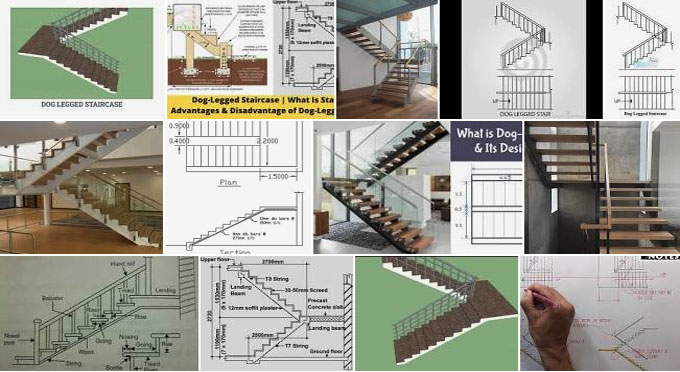
What is a Dog Legged Staircase?
One of the most economical staircases is the dog legged staircase, where stairs are arranged with two adjacent flights that runparallel with the mid-landing which is usually provided where there is a lack of space or when it is concerned with the economical use of available space.
The landing of the stair is at a level at which the direction of flight changes in this kind of staircase.
This article will discuss all about dog legged staircase, their advantages and disadvantages.
Introduction to Dog Legged Staircase
One of the simplest type of stairs is found in dog legged staircase where a flight of stairs moves one-half step before going 180 degrees and moving upwards.
The reason why this kind of stair is both popular and common is because of its appearance in sectional elevation. It consists of two flights that run in opposite directions which is separated by a landing in the middle space.
When the space available is equal to or twice the width these staircases are used. The stairs lie in a compact layout which provides a better circulation from a design point of view.
Components of Dog Legged Staircase
When there are several floors of the building, the stairs are able to provide access and there are landings at the right intervals after a series of staircases.
The stairs are made of individual steps where every step has a tread and a riser.
The vertical section between each step is the riser and the floor are the flat part on which you put a step.
According to the level landing is provided atthe direction in which the flight changes. It is the most economical ladder.
Requirement for Good Stairs
The following criteria is necessary for step for an easy, fast, and safe ascent or descent on a dog-legged staircase:
Location: A good amount of lighting and ventilation is required and also it must be accessible from all rooms.
Length of Flight: The maximum number of risers for a flight must be 16 and the minimum amount must be three.
Pitch of Stairs: The stairs are bent from 15 ? to 55 ?, where the recommended angle is between 25 ? and 40 ?. The landing must be used to level the long stride.
Landing: It is important for the width of the landing to be less than the width of the flight of stairs.
Step Proportions: Uniform rise of each stage on flights and landings between floors must be constructed as any variety can ruin the peace. Therefore, it is important to ensure comfortable access for the climb.
Exampleo of Dog Legged Staircase Design
Here is an example for the designing a dog-legged staircase for a residential building where the floor-to-floor height is 3.3 meters and the area which offered is 2.5 meters x 4.5 meters.
Solution: You must remember that for residential buildings, you have to consider riser and the tread of every step as 150 mm and 225 mm.
Therefore, the dimensions of stair hallis:
I = 2.5 m x 4.5 m
Height of Floor = 3.3 m
Total No. of flights = 2
Now,
Height of one flight = 3.3/2 = 1.65 m.
Therefore,
Rise = 150mm &
Tread = 225 mm
So, to calculate the Number of risers = 1650/150 =11.
Number of treads = 11-1 = 10.
The width of stair = 1.2 m
The length required for 10 treads = 10 x 0.0225 = 2.25 m.
Width of landing = (4.5-2.25)/2 = 1.125 m.
Advantages of Dog Legged Staircase
Stated below are the advantages of the dog legged stairs:
1. How efficiently space can be used: A less area is covered by the staircase which allows for the designing of a compact stair arrangement as compared to a straight ladder.
2. Privacy: In terms of privacy, if you want to separate one floor from another for any reason then these stairs can be used as these stairs provide enough privacy the reason being the top floor cannot be seen and vice versa.
Disadvantages of Dog Legged Staircase
The disadvantages of such staircase are stated below:
1. Construction of this type of stairs is difficult.
2. Careful planning is necessary for the handrails.


